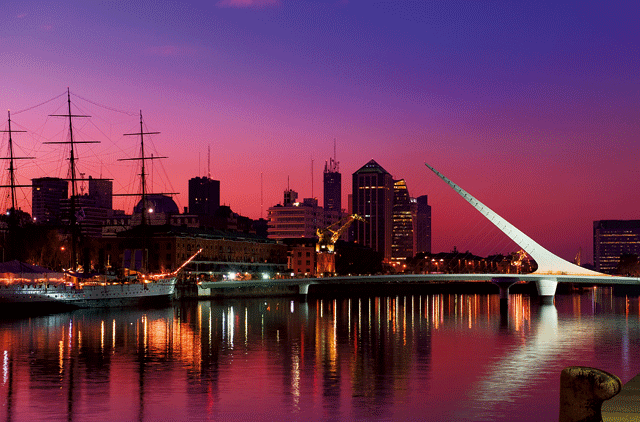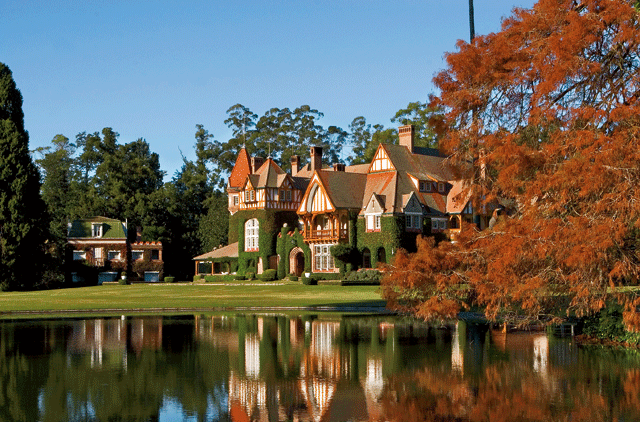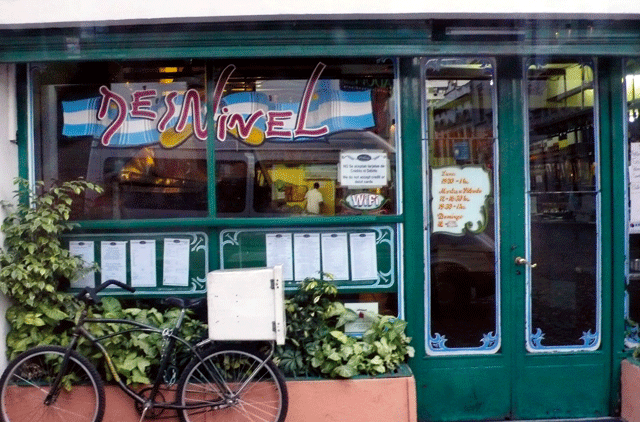
Reason 1:
The steak is the bestin the world
When people talk about Argentinian steak, they talk with such passion and pride that you can't help but feel it must be good. But you'll never know just how good until you've tucked into a hearty hunk of meat cooked by an Argentinian.
Meat is like a national treasure in Argentina, and any Argentinian worth his salt knows how to cook a good steak. Traditionally meat is cooked on an asado, which is an open fire grill. Simplicity is key in this cooking style, as no flavourings, aside from salt, are added to the meat. The types of meat and different cuts are cooked in a specific order, so be prepared to begin your meal with a meat starter. The more rustic and authentic the parrilla (a typical Argentinian restaurant), the tastier your steak is likely to be. And, don't be put off by the look of a restaurant - the Argentinians don't need much to produce a great feast.
The city's San Telmo area is filled with great restaurants, so it's well worth heading there in the evening to sample its authentic culinary delights. Des Nivel is a firm favourite with the city's residents, serving up morsels of tasty meat cooked over hot coals. It's now on the tourist radar, but nonetheless still offers up a really hearty feast of steak and papas fritas (good homemade chips) for roughly Dh30. (Des Nivel can be found on Avenida Defensa, San Telmo).
Vegetarians be warned - in typical restaurants non-meat dishes are limited to salad.
Reason 2
You can Tango
Tango plays a huge part in the city's rich historical makeup. To see tango proper, you'll have to befriend a local who might point you in the direction of an undercover bar for a glimpse of the real, gritty dance of passion. Failing that, most tourists head to one of the city's oldest barrios, La Boca, where street performers entertain for spare pesos.
If you're looking for something a little less street, then go to Esquina Carlos Gardel. Possibly one of themost famous and revered of Tango singers, the late Carlos Gardel is brought to lifethrough an evening of dinner, dance and song at this wonderful old theatre in the Puerto Madero barrio.
A three-course dinner is served up by an army of black and white clad waiters. The food is served fast and furiously, but tastes exceptional all the same. Served from 8:30pm, show-goers have two hours to eat and drink their fill before settling down to a mesmerising 90-minute performance of live song and music accompanied by a jaw-droppingly passionate display of tango. The room buzzes with good cheer and for a short time, the audience is transported back to Buenos Aires of old. Visit www.esquinacarlosgardel.com/ar to find out more.
Head to the falls
Iguazú Falls, less than two hours flight from Buenos Aires, is a Unesco World Heritage site and is currently vying for a top spot on the new natural Seven Wonders of the World list. The falls weigh in at 82m high, 150m wide and 700m long. Impressive, no?
The falls share borders with both Argentina and Brazil, and each side has its benefits for viewing this massive spectacle. Shaped like a giant horseshoe, the Argentinian side offers a system of paths and jungle walks that allow you to see the falls directly from above and below. The most popular sightseeing spot at the Devil's Throat gives visitors some idea of just how powerful this mass of flowing water is. Steam and mist rise up and block out the view of Brazil, while the sheer force of the waterfall literally takes your breath away. The National Park that surrounds the falls has an abundance of hiking and bird watching activities, and even though the area can be seen in one day, it's best to plan two as you will definitely want to go back and experience the falls again.
Stay: The Sheraton Iguazú Resort & Spa is the only hotel situated within the Iguazú National Park and offers views of the falls. Visit www.starwoodhotels.com/sheraton. Or try the Iguazú Grand Resort Spa, which is situated just 15 minutes away from the park. Visit www.iguazugrandcom. Argentina's airline, Aerolineas, offer daily flights to Iguazú from Dh1,000. Visit www.aerolineas.com/ar.
Need to know
Accommodation: Palacio Duhau Park Hyatt Buenos Aires, www.beaunosaires.park.hyatt.com
In true Park Hyatt style, the exquisite Palacio Duhau keeps allits charm and elegance of yesteryear while at the same time, providing all the modern day luxuries of a five-star hotel. Situated in the heart of affluent Recoleta, the hotel provides a perfect vantage point for easy access to the city's hot sightseeing spots. The hotel itself is housed across two buildings, an old and a new (ask your driver to drop you at the Palace or old entrance, which is utterly grand), offers a chic wellbeing spa, hosts its own private art gallery and has plenty to offer the discerning diner. Check the hotel's website for up-to-date prices and offers.
Getting there: Qatar Airways, www.qatarairways.com
Qatar Airways offers daily flights from Dubai to Buenos Aires, which go via Doha, before stopping in Sao Paulo and flying on to the Argentinian capital. Economy fares start from Dh6,235 return. If you want to upgrade for the 20-hour journey, return flights start from Dh24,385 for business class. A business class seat comes with the added bonus of a flat bed, a set of comfortable jersey pyjamas, delicious food as and when you want it, and a bag of Molton Brown toiletries to keep your skin fully hydrated for the journey.
Insider tip
You must try an empanada while in Argentina - a delicious pasty-like savoury treat that can be found on every street corner.
Revive your senses
A day trip to Estancia Villa Maria will do you wonders after a hectic week exploring Buenos Aires. Just 45 minutes outside of the city, this beautiful stately manor sits on 74 hectares of open green space and offers plenty of R&R to the weary traveller. Charming is just one word to sum up this peaceful retreat, as guests can enjoy a private picnic around the grounds, ride bicycles, indulge in a romantic carriage ride, go swimming, play tennis, take long walks in the park, or simply sit by the open log fire. Polo is also big here and often guests will be in for a really traditional treat with a polo exhibition. For Dh370 you can even sign up for your own lesson.
Estancia Villa Maria just has 11 rooms, so guests can relax and take advantage of the wide, open spaces. Room rates start from Dh1,100 per room per night, which is inclusive of full board and activities. If you don't have a night to spare, then you can enjoy a Dia de Campo (field day) package of Dh370 per person, from 10am to 6pm, which includes lunch and afternoon tea. If you contact the Estancia in advance they are also happy to put together a personalised Healthy Program for you - prices on request. Visit www.estanciavillamaria.com/eng.
Reason 3
The architecture is mesmerising
A great place to start your architectural tour of the city is at the politically-charged Plaza de Mayo, or May Square. Housing the city's Government House, more famously know as Casa Rosada, the City Council building, the Metropolitan Cathedral of Buenos Aires and the Bank of the Nation, Plaza de Mayo has seen more speeches (most memorably coming from President Juan Perón and his beloved wife Eva), protests, revolutions and rebellions than anywhere else in the country.
If you happen to visit the square on a Friday morning, you'll get a glimpse of the Mothers of the Plaza de Mayo - a group of mothers who still march en masse in protest of their missing children who disappeared during the ‘Dirty War' (between 1976 and 1983).
If you're keen on learning more about the city's political ups and downs, this is the ideal place to sit down with a guide book and cafetita (little coffee) before you start exploring. When you do decide to start your tour proper, head off along Avenida de Mayo and look up. You'll get a good idea as to just how grand Buenos Aires was in its heyday as the whole street is like a grand architectural museum. For more of where that came from, head straight to the city's most affluent barrio, Recoleta, which is home to its famous cemetery and gives visitors an insight into the Buenos Aires of the past.
Recoleta Cemetery is huge, and most people visit it for one reason - to see the final resting place of Eva Perón, who is more widely known as Evita.
The cemetery became the place where Buenos Aires' more affluent residents built their family crypts. Like a small city in its own right, the cemetery is laid out with proper avenues complete with street lamps and benches. The crypts themselves resemble miniature houses, as families would commission the same architects who had built their homes.
None of the graves are signposted, which makes the hunt for Evita all the more challenging - you could spend a whole afternoon wandering around the cemetery. Evita's own story is one of great intrigue. Her body was originally embalmed after death, then seized and disappeared for 16 years after a military coup. It then found its way to a crypt in Milan under a false name, before a brief stint in Spain, and finally came home to rest in the crypt of her brother's wife's family! Recoleta Cemetery is open daily from 8am to 6pm, admission is free, and on Tuesdays and Thursday at 11am, free guided tours are offered in English.
Reason 4
The people's passion is infectious
One local described the Argentine attitude as being similar to the tango - one of complete passion. And you can see why. When you're caught up in the dance, the mood flits between extreme sadness and raw, aching love - and Argentinians live their daily lives this way too.
To get a taste of this passion you only needto head to La Bombonera stadium in La Boca - hometo Boca Juniors, Argentina's most successful footballclub and, for a while, home of football legend Diego Maradona. You can book a tour through most hotels, which includes transport to and from the game, entrance and a guide who stays with you.
You don't really go to watch the football - the atmosphere is the big draw card as the roar of 60,000 over zealous fans rocks the three-tiered concrete stadium.
Another character-filled part of town is La Boca. This is one of the oldest areas in Buenos Aires and enjoys a rich Italian flavour thanks to an influx of early Italian immigrants. Today most people visitthe area to see the famousEl Caminito, or Little Path, which is a vibrant mix of colourful houses, street performers, bars, restaurants and tacky tourist shops.
You don't need to allocate a huge amount of time for La Boca, but it is a must-see part of town where you will understand the drastic difference between Beunos Aires' classes. A real gem for taking plenty of snap shots, here you can pay your way to dance with a professional tango dancer, capture it on film and stock up on tango memorabilia.
Reason 5
The city is an art haven
Buenos Aires lives and breathes art and you can visit the city's dedicated art spaces and museums to glimpse some of the works by world-renowned Argentinian artists.
However, if you prefer to see your art out in the open, then create your own tour of the city, which offers heaps of monuments and statues to ponder over.
One of the most famous is the Floralis Genérica, which was given to the city by artist Eduardo Fernando Catalano. An aluminium flower sculpture, the piece was built with a solar power element and reacts in accordance with the sunlight. At midday, the sleek metallic petals are spread out by the suns rays, while at midnight, the flower closes up.
Over the last ten years, a huge graffiti movement has taken hold of BuenosAires and in most barrios you will get a flavour of its underground art scene.
One company, Graffitimundo, offers three-hour tours of the city streets, to glimpse these contemporary art works. The tour concludes the city's only stencil bar, where you can buy artist's works or join a workshop and have a bash at your own. Tours are every Wednesday and Friday from 3pm to 6pm, priced at Dh70. This is a great way to see Buenos Aires at the start of your trip. Visit www.graffitimundo.com to book a tour.
If you happen to be in the city on the last Friday of the month, the art spaces and galleries of Recoleta open their doors to the public. You can appreciate the art and meet the artists who are happy to mingle with enthusiasts. Ask your hotel concierge for more information.
And, for serious art fans, you may want to think about visiting the city during arteBA - a five-day art fest, which showcases work not just from Argentina, but from all over Latin America. Visit www.arteba.org for more information. A
>> Features editor Charlene Stubbs visited Argentina courtesy of Qatar Airways and Park Hyatt.









